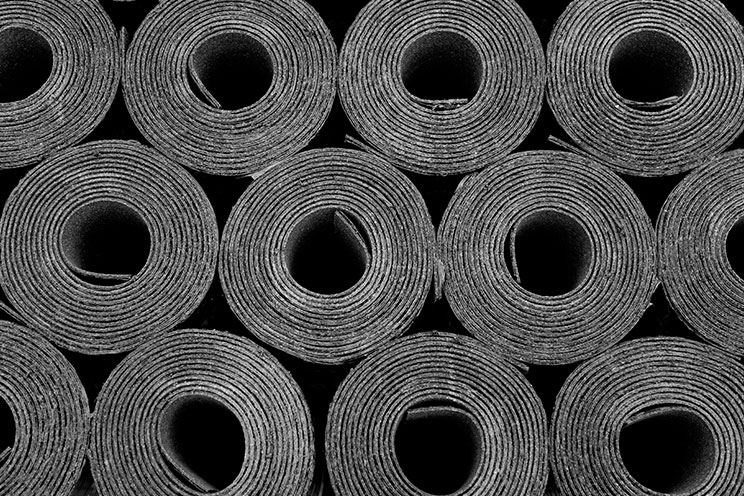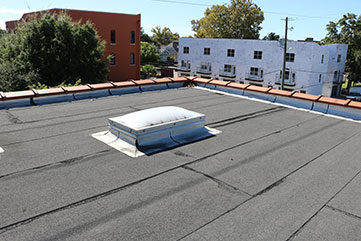
Over the past 50 years, modified bitumen roofing has changed from a novel experiment to one of the most widely used commercial roofing systems in the world. Globally, millions of projects implement this roofing material for its high tensile strength, long lifespan, and straightforward installation.
But what exactly is modified bitumen roofing, and what makes it better than other forms of commercial flat roofing?
This post covers various topics and tackles some frequently asked questions regarding this tried-and-true roofing membrane.
Have a modified bitumen roof in need of attention? Click here to find an American WeatherStar Approved Contractor near you.
What Is Modified Bitumen (Mod Bit)?
Modified bitumen is an incredibly sturdy yet flexible asphalt membrane mixed with polymerized rubber or plastic and fiberglass reinforcement. It evolved from built-up roofing systems, which have been employed on low-slope roofs for over a century.
Mod bit is common in commercial, industrial, and residential applications and ideal for use on flat and low-slope roofs. Depending on the material type, these systems generally consist of two or more layers (multi-ply).
The Origins of Modified Bitumen Roofing
Mod bit was first used commercially in the mid-1960s. Before then, most buildings implemented built-up roofing systems, a complex process of alternating layers of asphalt and felts (plies) topped with pea gravel (gravel BUR).
Although built-up roofs are a proven commodity, they are relatively inefficient, expensive to install, difficult to maintain, and susceptible to extreme temperatures. To address these shortcomings, developers combined bitumen with rubber polymers and fiberglass reinforcers to produce a simpler, more manageable roofing application.
Ultimately, these endeavors led to the earliest forms of modified bitumen, producing a long-lasting, easy-to-install roofing membrane with superior resistance to extreme temperatures.
By the mid-1970s, mod bit had surpassed BUR as one of the most dependable roofing materials in the United States.
Types of Mod-Bit Roofing Membrane
SBS (Styrene-Butadiene-Styrene)
SBS is essentially “elastic” or “rubberized” asphalt. The combination of asphalt and polymerized rubber produce a membrane with superior elasticity and flexibility. SBS is ideal for rooftops encountering large temperature swings and heavy winds.
APP (Atactic Polypropylene)
APP, commonly referred to as “plastic asphalt,” is composed of asphalt and plasticized polymers that expand at higher temperatures. Compared to SBS, APP offers better UV resistance.
The Pros of Modified Bitumen Roofing
Tear Resistance
Modified bitumen membranes have high tensile strength, providing superior protection against punctures and tears usually caused by storm damage, wind-driven debris, foot traffic, etc.
Waterproofing
Modified bitumen roofing offers excellent waterproofing protection—especially multi-ply mod bit systems.
Easy to Install and Maintain
The installation of a mod-bit system is a relatively simple process. Also, as a rolled membrane, it patches quickly and efficiently if damaged.
Energy-Efficient
Some forms of mod bit are highly UV resistant and reflect the sun’s rays, resulting in decreased energy costs.
The Cons of Modified Bitumen
Longevity
With an average life expectancy of about 20 years, modified bitumen roofing has a considerably shorter lifespan than other materials.
Heat Absorption
Dark-colored mod bit membranes do not effectively reflect heat from the sun, resulting in higher temperatures for building interiors—especially if roof insulation is inadequate.
Risk of Damage
Modified bitumen roofs are highly durable but more prone to damage if routinely walked on. They also tend to accumulate ponding water during heavy rainfall. Like any other flat roof system, excessive wear and tear can shorten service life and functionality.
Produces Strong Odor
Installing a mod bit roofing system produces a lingering pungent stench. It is advisable to relocate building occupants while the roof is being installed.
Off-Gassing
Torch-applied modified bitumen produces heavy fumes. Without the proper safety equipment, the vapors emitted during this operation can be hazardous to health and the environment.
Modified Bitumen: Frequently Asked Questions
With proper upkeep, a mod-bit roofing system should last up to 20 years. At best, poorly maintained mod-bit roofs will only last about ten to twelve years.
Several variables influence the longevity of a mod bit roofing system, including installation quality, routine maintenance, and repairs, regularly-scheduled inspections, etc.
Mod-bit roofs cost anywhere from $5 to $12 per sq. ft. Many factors impact their price, such as roof size, roof construction, material type, number of penetrations, etc.
Modified bitumen is most commonly sold in rolls that are adhered directly to roofing substrates. The material can be heat welded, cold-bonded, or occasionally self-bonded.
Mechanical attachment is another option for some modified bitumen membranes. In most applications, at least two layers—a base layer and a cap layer—are required, but in rare circumstances, a multi-ply system with three or more layers may be placed.
The United States began utilizing built-up roof (BUR) systems in the 1800s. A flat roof is insulated using this design, which uses thick layers of tar or asphalt.
On the other hand, the insulation, vapor barriers, and fused membranes employed in a modified bitumen roof are comparatively much lighter than built-up roofing systems.
The installation of a mod bit roof is less taxing on the infrastructure that supports loads, even if both choices for flat roofs may be suitable. It also takes less time.
Mod-bit roof repairs are pretty straightforward. In most cases, the process involves:
- Removing damaged the portion of the membrane
- Replacing it with a patch of new modified bitumen material
- Sealing the patch with a roofing-grade sealant
It is recommended that all repairs be performed by a roofing specialist certified to work with mod-bit materials.
It is essential to conduct semi-annual inspections (usually in the spring and fall) to spot early warning signs of wear and to determine if any repairs are necessary.
This procedure often prevents the needless repair of the structure, which can cost tens of thousands of dollars. Additionally, scheduling a roof inspection after a hailstorm or strong winds is highly advised.
Click here to learn more.
Absolutely. Mod bit roofs are great candidates for elastomeric coating systems. For these systems to be effective, the existing roof membrane must be in good condition and free of saturated insulation.
To learn more about the benefits of roof restoration, check out this post: Roof Restoration: The Comprehensive Guide
If appropriate measures are taken, modified bitumen can be installed in cold weather. The key is to select materials for the most significant outcomes for installation in cold temperatures.
Conclusion
The benefits of mod-bit include its dependability, low maintenance requirements, and eco-friendly attributes. While the installation method and longevity are negatives that individuals take into account. Modified bitumen roofing has always retained its footing by utilizing its advantages over negatives. It has been a dependable option for roofing despite rival flat roofing solutions like TPO and PVC.
To learn more about the benefits of mod bit and fluid-applied roof restoration from American WeatherStar, click here to speak with a customer service representative.
Related Posts
Polyurea Coating: The Complete Guide
Polyurea is an incredibly versatile coating material with numerous commercial, industrial, and residential applications. It is best known for…
EPDM “Rubber” Roofing: The Complete Guide
EPDM roofing systems are quite common on commercial and industrial buildings. In fact, until recently, EPDM was the most popular commercial…
The Ultimate Guide to TPO Roofing
TPO roofing systems are an extremely popular choice for commercial and industrial buildings. TPO is a highly durable, UV resistant, and…








